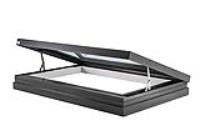 Add My Company
Add My Company
Sign In
Can I install a glass rooflight anywhere?
12-12-2015

Glass rooflights come in all shapes and sizes and can perform a variety of functions from simply improving the amount of natural daylight within a room, providing ventilation and in some cases a means of accessing an outside space.
Provided you comply with Building Regulations rooflights can be installed almost anywhere in a domestic building.
However, it always pays to think about why you want your glass rooflight in the first place in order to ensure you get the most from your investment – what issue will it solve or what area will it dramatise? How will you be using the room it’s installed in?
In this post we take a look at the various areas of your home and how glass rooflights can be utilised for maximum impact.
Rooflights for lounges and sitting rooms
There aren’t too many things to be concerned about in this application and most rooflights can be considered. Generally speaking the area is well ventilated and does not contain high levels of moisture so no concerns about condensation. The lounge or sitting room is however used more frequently than most and lets face it, almost all of us watch the TV in our lounge – consider the amount of direct sunlight that your rooflight allows into the room and where this falls in relation to the TV, or even soft furnishings where excess direct sunlight can cause fabrics to fade.
If this room is south facing and gets a large amount of sunlight in the summer, then you may wish to consider a higher specification solar control glass to reduce solar gain.
Installing a rooflight in your kitchen or dining area
Depending on your interior decoration and fittings, kitchens can sometimes appear a little darker than other rooms; you also face a higher risk of condensation build up on cold surfaces when cooking, particularly where there is poor cross ventilation.
Careful consideration should be given to both type and placement of your rooflight to achieve maximum results. If cross ventilation is good enough and cooking areas have sufficient methods of extraction then fixed rooflights can be used very effectively to naturally light up worktops and food preparation areas such as breakfast bars or kitchen islands.
If cross ventilation is a problem, then you could consider a ventilation rooflight as a means of improving this whilst at the same time increasing natural daylight. Sliding rooflights remain an excellent choice in ventilating a room as well as connecting eating areas to the outdoors in the summer months.
All of these options are also great for use in dining areas, which today are often open plan and form part of the kitchen itself. Many people will consider lantern rooflights positioned directly above a dining table, as a central focal point and means of lighting the area. This is often used as a communal space where people can have a coffee whilst reading the paper, or the kids can sit and do their homework.
Should I put a rooflight in a bedroom?
Pretty much any glass rooflight can be installed above a bedroom, but if you are using this room in the traditional sense, to sleep (as opposed to a study for example) then you should think about black out blinds for the summer months, unless you enjoy an early start!
Things to think about when installing rooflights in a bathroom
Your bathroom is going to be subject to much higher levels of moisture than any other room in the house so condensation will always be an important aspect to think about.
Provided you have effective extraction devices installed then fixed rooflights will not pose any problem, although you will still run the risk of condensation forming on the rooflight on really cold days.
Ventilation rooflights can perform well in this environment to assist with allowing steam from showers and baths to evaporate out of the room; however ensure that any electrically operated rooflights are installed by a qualified electrician and always consult Building Regulations with regard to placement of power supplies and operating switches.
Unless you are an exhibitionist you may also want to consider whether the rooflight is overlooked by any neighbouring properties when installing over a bathroom.
Lighting hallways and corridors with glass rooflights
There should be no problems here and rooflights are exceptional at lighting up these traditionally darker areas of a building; it is possible to manufacture entire ribbons of glass using modular arrangements that can quite literally provide a glass ceiling to an entire corridor.
Rooflights in terraces and patios
Rooflights in patios will usually be installed to allow natural daylight to penetrate into the room below, for example a basement room can be turned into a home gym or study by installing a rooflight at ground level above.
Often these will be specified with walk on specification glass so that the patio area itself can be fully utilised without sacrificing any space.
Roof terraces are also a great way of increasing usable space in a building, so in addition to walk on specification glazing, some glass rooflights can be used as the means to access this space.
There are various types of products on the market today, ranging from basic cost effective manual access hatches, electrically hinged access products to fully fledged sliding box rooflights that act as a physical structure, enabling the user to press a switch at the bottom of the stairs and walk out of the rooflight at the top.
For more information give us a call on 01379 353 716 or browse our online rooflights shop.
For more information on Can I install a glass rooflight anywhere? talk to rooflights.com
Enquire Now
More Case Studies & Blogs
List your company on FindTheNeedle.

